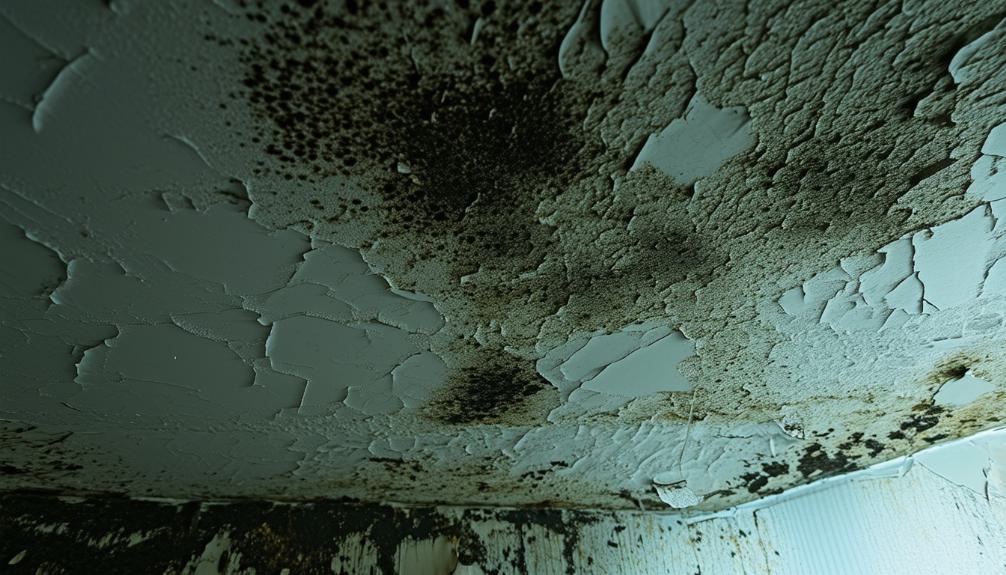Is black mold on your bathroom ceiling dangerous? This is a common concern for many homeowners. Discovering those dark spots above can be alarming, especially with the health risks often associated with mold exposure.
Worrying about respiratory issues, allergies, and potential structural damage can be overwhelming. But don’t panic just yet.
In this article, we’ll dive into the dangers of black mold, its impact on your health, and effective ways to tackle this pesky problem. Stay tuned for expert advice and practical solutions to keep your home safe and mold-free.
Key Takeaways
- Black mold is dangerous, causing respiratory problems, asthma, and neurological issues, especially for vulnerable individuals like children and the elderly.
- Identify black mold by looking for dark green or black patches, musty odors, and damp, hidden areas like behind tiles and under sinks.
- Prevent black mold by keeping humidity below 50%, using exhaust fans, fixing leaks promptly, and regularly cleaning surfaces prone to mold.
- Treat small mold areas with water and detergent; for larger infestations, hire professional mold remediation services and ensure proper protective gear.
Is Black Mold on the Bathroom Ceiling Dangerous?
Yes, black mold on the bathroom ceiling is dangerous. It produces toxic spores and mycotoxins that harm respiratory health. Exposure can lead to asthma, chronic lung disease, and neurological issues. Children, the elderly, and those with compromised immune systems are particularly vulnerable.
Symptoms of exposure often improve once you’re away from the mold-infested area. Bathrooms are common mold hotspots due to high humidity and poor ventilation. To mitigate risks, ensure proper ventilation and address any moisture problems promptly.
Health Risks
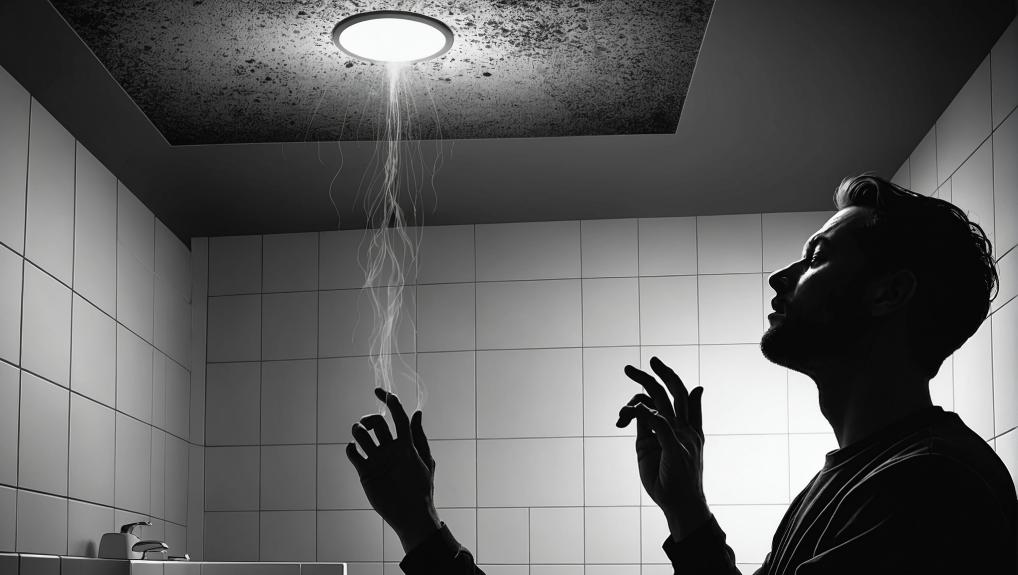
Understanding the serious health risks of black mold is crucial due to its toxic spores and mycotoxins, which can severely impact our respiratory systems. Black mold exposure can lead to conditions like asthma and chronic lung disease, making prompt action essential.
Extended black mold exposure affects more than just our lungs. It has been linked to neurological issues and mood changes, highlighting its broader impact on well-being. Those with compromised immune systems, children, and the elderly are especially vulnerable to its severe effects.
Symptoms of black mold exposure include eye irritation, coughing, sneezing, and skin irritation. Continued exposure can worsen these symptoms. Notably, if symptoms improve when away from the affected area, it suggests a direct link between mold presence and health issues.
Removing mold from living spaces is crucial for a healthier environment.
Identification
Identifying black mold in the bathroom is crucial for mitigating its health risks. You can often spot black mold as dark green or black patches on the ceiling or walls.
It thrives in damp, humid environments and usually appears in areas with moisture sources like leaks or condensation. It often hides in corners where moisture collects.
A musty odor often accompanies black mold. When inspecting, check more than just the obvious spots. Hidden areas, like behind tiles or under sinks, can harbor growth that’s not immediately visible. These areas can be prime locations for mold to thrive unnoticed.
Small black spots that spread quickly indicate moisture issues. Address them immediately to prevent further mold growth. By catching these signs early, you can stop mold from becoming a bigger problem.
Regular visual inspections and awareness of mold’s signs help maintain a safer, healthier bathroom environment. This vigilance ensures freedom from black mold’s health risks.
Common Locations
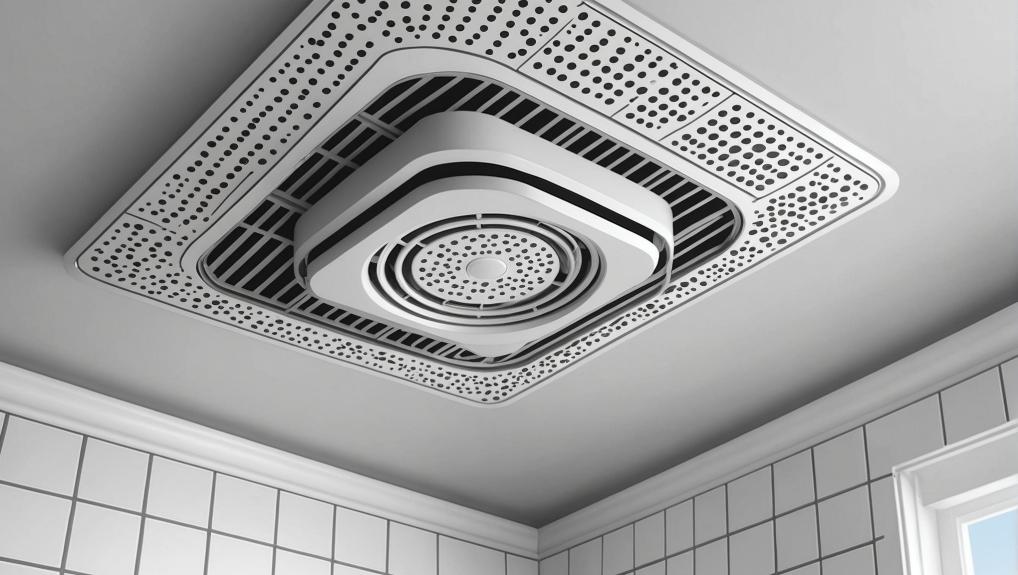
Black mold often thrives in bathroom corners where condensation gathers. This typically occurs in ceiling corners, where steam from hot showers accumulates and creates a damp setting.
The grout between tiles and around tub surrounds is another frequent spot for mold, especially when ventilation is inadequate or leaks are present.
Bathrooms provide an ideal environment for mold, particularly behind drywall near showers and tubs. These areas are regularly exposed to water, making them prime candidates for mold growth. Under sinks, where moisture can accumulate unnoticed, is another common hotspot.
It’s also important to watch for mold around pipe fittings and behind mirrors or cabinets. These locations often stay damp and can remain hidden from view, necessitating regular inspections. Mold can be sneaky, hiding in less visible areas, complicating detection and remediation efforts.
Prevention Tips
To prevent black mold in the bathroom, keep humidity levels below 50% and use exhaust fans during and after showers. This reduces moisture and improves ventilation, critical factors in stopping mold growth.
Keeping the bathroom dry is essential; opening windows after showers can enhance air circulation and lower humidity.
Regularly inspect plumbing fixtures for leaks. Address any leaks or water damage promptly to prevent mold proliferation. Clean and dry surfaces prone to mold, like tiles and grout, regularly.
Using mold-resistant paints and materials provides an added barrier against mold, making it harder for mold to take hold and spread.
Treatment Options
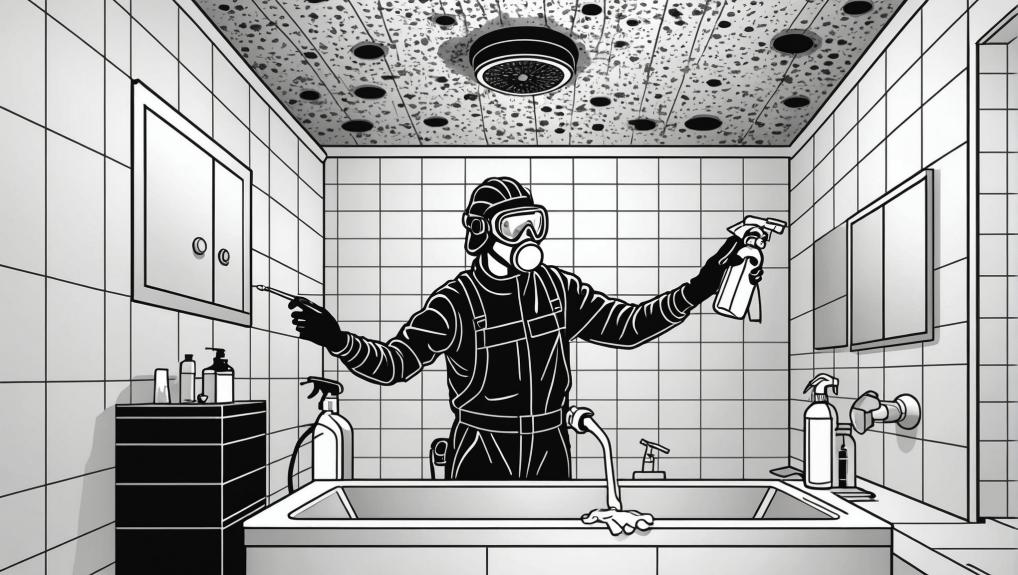
To tackle black mold in the bathroom, start by treating small areas with a mixture of water and detergent. This method works well for minor infestations and offers a straightforward solution.
If the mold covers a larger area, call professional mold remediation services due to health risks. Begin by removing affected materials like drywall or insulation to prevent mold spread. Following the initial cleaning, apply antifungal solutions to stop future growth.
Wear protective gear, including masks and gloves, to minimize exposure to toxic spores and mycotoxins released by black mold.
After mold removal, continuous monitoring and maintenance of the bathroom environment are crucial. Keep humidity levels below 50% and ensure proper ventilation to prevent mold recurrence.
For extensive mold growth or persistent moisture issues, professional services may be necessary. Experts can provide thorough remediation and address underlying problems contributing to the mold issue.
Legal Considerations
Landlords must address mold issues, including black mold, to comply with housing regulations aimed at ensuring safe and healthy living environments.
These regulations vary by location but share the core principle of maintaining tenant safety. When black mold appears, tenants should report it to their landlords immediately. This ensures the issue is handled according to health and safety standards.
Ignoring mold problems can lead to severe legal consequences for property owners. If tenants experience health issues due to mold exposure, landlords could face lawsuits and significant financial liabilities. To avoid this, landlords should stay informed about local health department guidelines and available resources for mold management.
Both tenants and landlords need to understand their rights and responsibilities regarding mold remediation.
Regulations typically require swift action to address mold problems and minimize health risks. By adhering to these legal requirements, we can ensure that living spaces remain safe and habitable.
It’s crucial for everyone involved to take mold issues seriously and act promptly to resolve them.
Causes
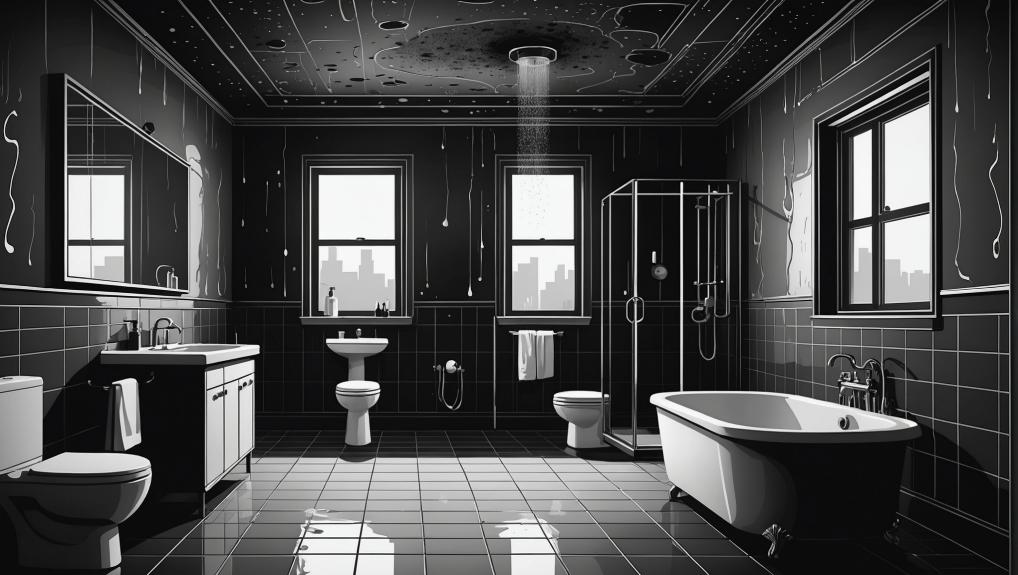
Black mold in bathrooms arises primarily from water and dampness, creating an ideal environment for its growth. High humidity, especially above 50%, significantly contributes to mold development. Poor ventilation exacerbates these conditions, making them even more favorable for mold.
Warm, moist air from hot showers leads to condensation on surfaces, providing the moisture necessary for mold to proliferate.
Leaky pipes or roofs can introduce excess water into bathroom areas, worsening the conditions that allow black mold to thrive. Addressing these leaks promptly is vital to prevent mold from gaining a foothold.
Organic materials commonly found in bathrooms, such as wood and drywall, serve as food sources for mold. When damp, these materials provide an ideal breeding ground.
Frequently Asked Questions
How Long Does It Take for Black Mold to Grow on a Damp Ceiling?
Black mold can start growing on a damp ceiling within 24 to 48 hours. To prevent mold from spreading, keep humidity levels below 50% and ensure proper ventilation.
Can Black Mold in the Bathroom Spread to Other Parts of the House?
Black mold in the bathroom can indeed spread to other parts of the house. Its spores travel through air systems, settling in different rooms. This can lead to widespread infestations and significant health risks. Addressing the issue promptly is crucial to prevent further contamination.
Are There DIY Kits for Testing Mold in the Bathroom?
Yes, there are DIY kits available for testing mold in the bathroom. These kits allow you to collect samples and send them to a lab for analysis. While they provide a preliminary assessment, consulting a professional for a comprehensive evaluation is often advisable.
Conclusion
Black mold on the bathroom ceiling is dangerous. It can cause a range of health issues, including respiratory problems, allergies, and even toxic reactions in some cases.
To ensure our health and safety, we must regularly inspect common areas like bathrooms, take preventive measures such as proper ventilation and moisture control, and promptly treat any mold we find.
Understanding the risks, identifying its presence, and knowing how to effectively deal with it will help us maintain a safe living environment.
By staying proactive, we can protect ourselves and our loved ones from the potential dangers of black mold.

